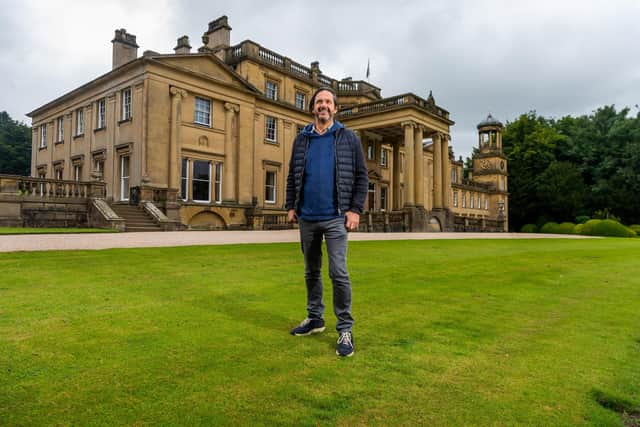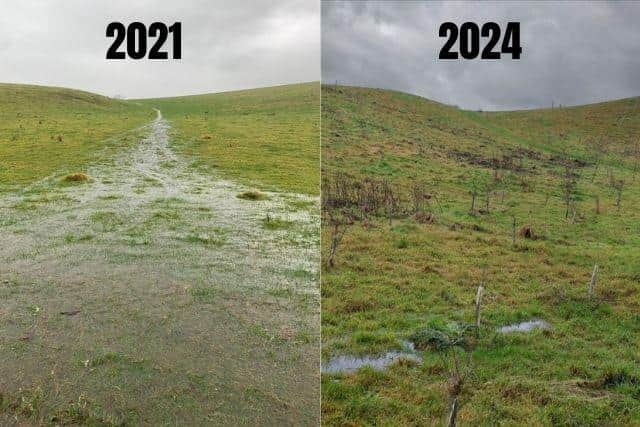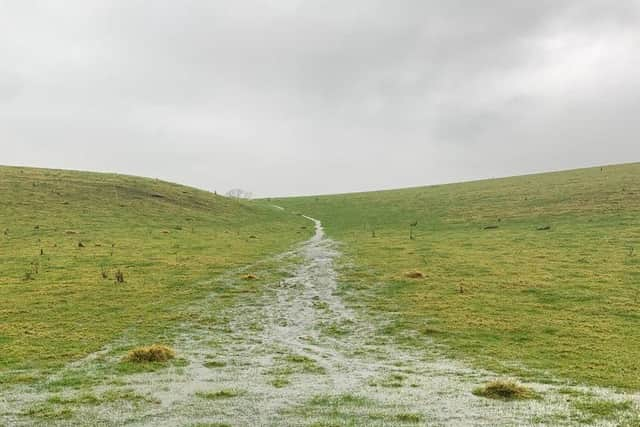Re-wilding scheme in Yorkshire is hailed as key method to tackling flooding and extreme weather events
Since 2021 the estate of Broughton Sanctuary, near Skipton, has been on a mission to rewild 1,100 acres – which is around one third of its land.
This includes planting 230,000 trees and reducing sheep grazing, allowing the soil to hold more rainwater and slow runoff into nearby rivers.
Advertisement
Hide AdAdvertisement
Hide AdThree years on, new photos and statistics have been released which show the effect that the efforts are having on alleviating flooding in the area.


In January 2021, when sheep still grazed the fields and before large-scale tree planting had begun, 131mm of rainfall over the previous four weeks produced huge amounts of surface water. This quickly found its way into the river systems due to the compacted nature of the soil.
In comparison, after 133mm of rainfall in the four weeks leading up to January 2024 photos show significantly less surface water, with rain soaked up by the more sponge-like wild grassland and released more slowly into the river system.
Prof Alastair Driver, director of Rewilding Britain, says that there are multiple benefits to Broughton Sanctuary’s scheme and flood reduction is just one.
Advertisement
Hide AdAdvertisement
Hide AdHe said that variety in the ground surface as opposed to it being like “a snooker table” is key to the soaking up of rainwater.


Prof Driver said: “It’s not the trees themselves that are doing the bulk of the work here. As you can see from the photos, the trees are still very small.
“Previously when rain fell in this area it was landing on soil that had been compacted by the pitter patter of tiny sheep feet. This creates a ‘pan effect’ and causes the water to run straight down the hill. It is like a snooker table because of how short the sheep keep the grass.
“Now the sheep have been moved and we have broken up that surface soil, letting wild grasses grow, which allows water to soak in far easier. The ground and grass now acts like a sponge, slowly releasing the water into streams and rivers over time rather than all at once, so we don’t see water levels rise so rapidly.”
Advertisement
Hide AdAdvertisement
Hide AdHe says the benefits of the project should also improve over the next few years as the trees mature.


There are also calls for this type of scheme to be rolled out on a much larger scale and Prof Driver says that with farmers facing changes to basic payments, which subsidises sheep farming, re-wilding could create opportunities for more environmental schemes – and the promotion of having rare breed cattle.
Prof Driver said: “We are seeing some settlements with frequent extreme weather events, once every ten years for example, become perhaps once every five years instead. This not only will have a major impact on people’s property, but also vital infrastructure like roads and railways.
“This approach to flood management doesn’t need exploring or investigating any more. We don’t need more talk, we need more action like is being taken at Broughton Sanctuary. We have repeated examples from around the country over the last 20 years that have been measured and assessed, and we know it works.
Advertisement
Hide AdAdvertisement
Hide Ad“It is time to stop talking and roll this approach out at much greater scale. Currently only one per cent of the flood budget is spent on this kind of scheme across England. It’s not a silver bullet but it should be at least 10-20 per cent, and then we would see widespread benefits.
“Sheep farming in this country is subsidised by the Basic Payment Scheme and that is being phased out, so it is important we now support farmers to farm more sensitively. In Broughton we will be switching to extensive rare breed cattle, for example, which will continue to produce food – it’s all about pragmatic rewilding and it can have huge benefits across the country.”
The Broughton Hall Estate has been home to the Tempest family for more than 900 years after having being established in 1097.
However, it recently changed its name from Broughton Hall Estate to Broughton Sanctuary as it adopts a new vision to create grounds that are a a regenerative space and more sustainable for future generations.
This includes less intensive farming, planting of trees and woodland and creation of wildlife ponds and habitats.
Comment Guidelines
National World encourages reader discussion on our stories. User feedback, insights and back-and-forth exchanges add a rich layer of context to reporting. Please review our Community Guidelines before commenting.
